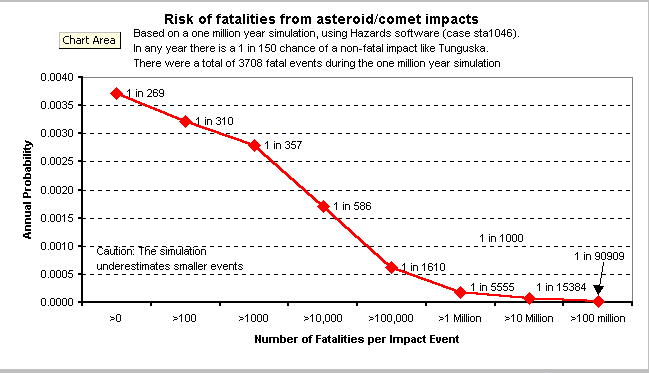Simulation of Asteroid/Comet Impacts with Earth
![[TPSAVC Site map]](tps_map.jpg)
Simulation 1046: One million years looking at worst event each century.
By Michael Paine 6 Jan 2000[Freq of events] [Impactor diameter] [Fatalities by impactor diameter] [Distribution of fatalities] [(Low) Freq of craters]
This page provide further information about the simulation described in my Explorezone/Space.com article "SIMULATING ARMAGEDDON ON YOUR PC: ASTEROID IMPACTS WITH EARTH".
If you have a copy of the software check out, and contribute to, the Users Page.The computer program is available on diskette distributed with the book "Comet and Asteroid Impact Hazards on a Populated Earth" by John S. Lewis, Academic Press. It was released late in 1999. See review.
Due to its random nature, each time the program is run it generates a completely different set of results. The overwhelming influence of a few horrendous events means that the total number of fatalities can vary considerably between successive runs.
Set out below are the results of a total of one million years of simulation, looking at the worst event in each of 10,000 centuries. I want to stress that these are NOT predictions and that no known NEOs are on a collision course with Earth.
Although one million years seems a very long time, bear in mind that impacts do not run like clockwork - they could occur at any time. An event which happens once in one million years of the simulation has a one-in-a-million chance of happening in the next twelve months. This should not be dismissed as unimportant, particularly if it could involve billions of deaths and the end of civilisation. After all, many optimistic people around the world regularly buy lottery tickets where the chance of winning first prize is one in 30 million or worse. The chance of getting dealt a royal flush in 5 card poker is about one in half a million.
In my simulation the total death toll during one million years was 7.5 billion. This represents an average of 7,500 fatalities per year and is higher than the 3,000 fatalities per year generally quoted by scientists. However, nearly half of these fatalities occurred in one devastating event that wiped out half of the world's population - a possible outcome in the real-life gamble with rocks from space.
To put the NEO death toll in perspective, it lies somewhere between that of earthquakes (10,000 per year) and airline crashes (700 per year).Only the worst event in each century was considered in my simulation. Other fatal events may occur but are not included in the death toll. The death toll from smaller NEOs is therefore an under-estimate. See the 10,000 year simulation looking at the worst event in each decade for the influence of smaller impactors.
The original program uses a tsunami runup factor of 30 (the height of the wave at the shoreline was assumed to be 30 times the height of the wave in deep water). A more conservative runup factor of 5 was used in the simulation.
The program is mainly intended for runs covering a several thousand years. In these time periods impacts massive enough to cause global climatic trauma are extremely rare and the program did not fully account for these effects. Lewis and others suggest an explosion equivalent to one million megatons of TNT would be sufficient to cause over a billion human fatalities, mainly due to global starvation. A typical asteroid about 1 mile across would do the trick. Global climatic effects probably become insignificant for asteroids smaller than 500 yards across, with a typical explosion of 10,000 megatons of TNT (some 200 times larger than an H-bomb). The potential fatalities from these climatic effects have been included in the following fatality estimates.
Asteroid/comet diameter is estimated from mass (randomly generated by the program) and density (derived from the type of object - also randomly generated).
A constant world population of 5 billion people is assumed. It is also assumed that impacts occur without warning (the current situation) and that there is no time for evacuation or preparation, such as stockpiling of food supplies.
Summary Data



